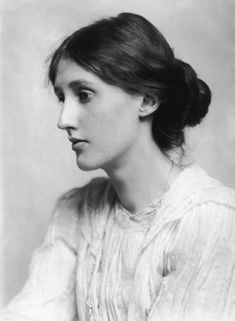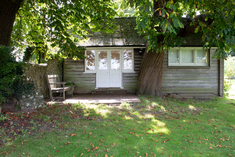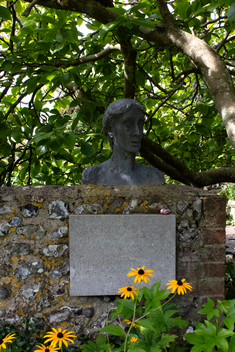A poem about Virginia Woolf
By Bianca Manu, 2023In 2023 writer Bianca Manu researched into the life and works of Virginia Woolf. This was for a project exploring statues and memorials in Camden. There is a bust of Virginia Woolf in Tavistock Square. She wrote the poem below, with accompanying numbered notes, in response to what she found out.

In 2023 writer Bianca Manu researched into the life and works of Virginia Woolf. This was for a project exploring statues and memorials in Camden. There is a bust of Virginia Woolf in Tavistock Square. She wrote the poem below, with accompanying numbered notes, in response to what she found out.






Virginia Woolf by Bianca Manu
Freedom
has many faces:
By nature and form,
There are several phases.
Waxing and waning
A regular reshaping
Like a sun, not yet risen 1
Constantly shifting, in transition
Freedom elicits contradiction.
Fact relaxes, begetting fiction. 2
Aided by money and private spaces, 3
‘A change of temper a fixed income’ created. 4
‘Fear and bitterness’ dissipated, 5
Until the point of emancipation:
‘the freedom to think of things’ without commiseration. 6
For Woolf, she exercised her liberation,
Her autonomy translated into literary inspiration.7
And so, the sun rose. 8
She wrote prolifically.
Preoccupied with documenting society,
Virginia remained reserved politically. 9
When the Sun had risen to its full height. 10
She resented the spotlight. 11
Feminism and anti-imperialism, she did endorse. 12
Through Hogarth Press, she published progressive discourse 13
She spoke in favour of women’s autonomy 14
For those and others, she elevated 15
Writers Ling Shuhua, Ahmed Ali and Nancy Cunard 16
Woolf was formidable at setting a new standard.
A complicated tour de force
Who expressed incendiary views with no remorse:
Unrefutably an anti-Semite. 17
‘Fear and bitterness’, she spoke in spite.
The Sun was sinking 18
How do you reconcile this volatility?
Separate politics from her literary?
Like sun, we are both dusk and dawn.
Our positions are forever changing form.
No person is ever fixed.
We all navigate internal conflict.
All of us make questionable remarks.
Each of us, both light and dark.
Every opinion will invariability separate.
We must not cancel or commiserate.
Instead, to write in retrospect,
It is a gift to reflect.
Can we offer some small grace instead?
Notes for the poem
In the poem above, Bianca has added numbers to the end of some of the lines. These correspond to the notes below.






1 In The Waves, the sun is presented to the reader as a reoccurring interlude to each chapter; this symbol is only visible to the audience, while the characters experience the change in an abstract and incremental way. By writing about the gradual shift of the sun, waves and trees, Woolf adopts a position of omnipresence to foreshadow the physical and psychological state of the characters. In writing of the sun, she becomes the sun, her comparable to the rising and falling of a constant but everchanging orb of light. Woolf, Virginia. 2016. The Waves :[Vintage Classics Woolf Series]. London: Vintage. Pg3. More on the structure of the Waves: Payne, Michael. 1969.“THE ECLIPSE of ORDER: THE IRONIC STRUCTURE of ‘the WAVES.’” Modern Fiction Studies 15 (2): 209–18.
2 Woolf is transparent about how a ‘certain number of pieces of paper which were left me by my aunt’ shifts her focus as a writer: ‘before that made my living by cadging odd jobs from newspapers, by reporting a donkey show here and there...all this became like a rust eating away the bloom of spring, destroying the tree at its heart’. The financial freedom allowed her to ‘bloom’: to write fiction. Woolf, Virginia. 1929. A Room of One’s Own. London: Hogarth Press. Pg29.
3 ‘No force in the world can take from me my five hundred pounds. Food, house, and clothing are mine for ever’. Woolf, A Room of One’s Own. Pg30.
4 Woolf, A Room of One’s Own. pg30.
5 Woolf, A Room of One’s Own. pg30.
6 Woolf, A Room of One’s Own. pg30.
7 Between 1915 – 1941, Virginia Woolf wrote 9 novels, including seminal works Mrs Dalloway (1925); Orlando (1928) and Between the Acts (1941); 23 short stories, and three long essays.
8 Woolf, The Waves, pg.50.
9 Woolf initially concealed her political views as a tactic, which she eventually confesses, ‘Secrecy is essential, We[women] must still hide what we are doing and thinking...when salaries are low...and jobs are hard to get and keep...it is rather tactless...to criticize your master’. Although financially independent, criticism weighed on Woolf. It wasn’t until her later years she was able to speak of her opinion confidently as ‘facts’. Woolf, Virginia. 1938. Three Guineas. New York. Harcourt, Brace, World. Pg120.
10 Woolf, The Waves, pg.104.
11 Virginia Woolf ‘hated being looked at and needed much persuading to even sit for a portrait’. Charleston. Bust of Virginia Woolf. Charleston.
12 Woolf is hailed to some extent ‘as feminist (Black, N, 2004), with the acknowledgement that her position changed in her publications between 1920 – 1940, from ambivalence (Park, SS, 2005, 119) about suffragism to pacificism...her involvement with the Working-Class Women’s Guild’ to activism [quote Samantha Allen report]
13 In 1917, Virginia Woolf and her husband, Leonard Woolf founded Hogarth Press, named after their house in Richmond, which played a key role in publishing anti-colonial literature and works by writers of colour.
14 Woolf believed in the idea of the New Woman: being financially and socially independent from the constraints of marriage and motherhood. She explores this position ideologically through Orlando, and characters such as Rose Pargiter in The Years, Hulia Hedge in Jacob’s Room, and Mary Dachet in Night and Day. [quote Samantha Allen report]
15 Hogarth Press also published Trinidadian historian and Marxist, CLR James and Gertrude Stein’s Compositions as Explanation, in 1926.
16 Hogarth Press supported Ling Shuhua, a Chinese modernist writer; Ahmed Ali was one of the first Muslim authors to be published in English; Nancy Cunard was an anti-racism campaigner wrote the poem, Parallex (1925)
17 [Quote from selected diaries]
18 Woolf, The Waves, pg.149. See Carroll, Berenice A. “‘To Crush Him in Our Own Country’: The Political Thought of Virginia Woolf.” Feminist Studies 4, no. 1 (1978): 99–132.